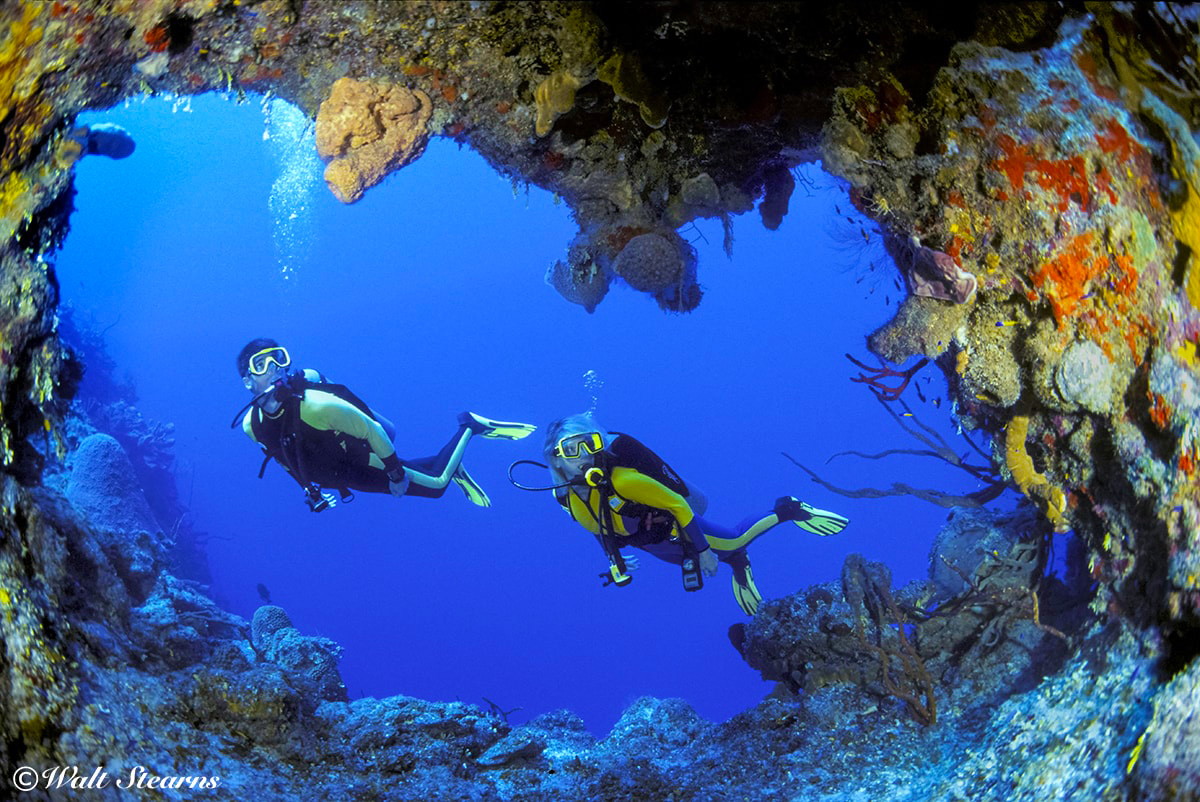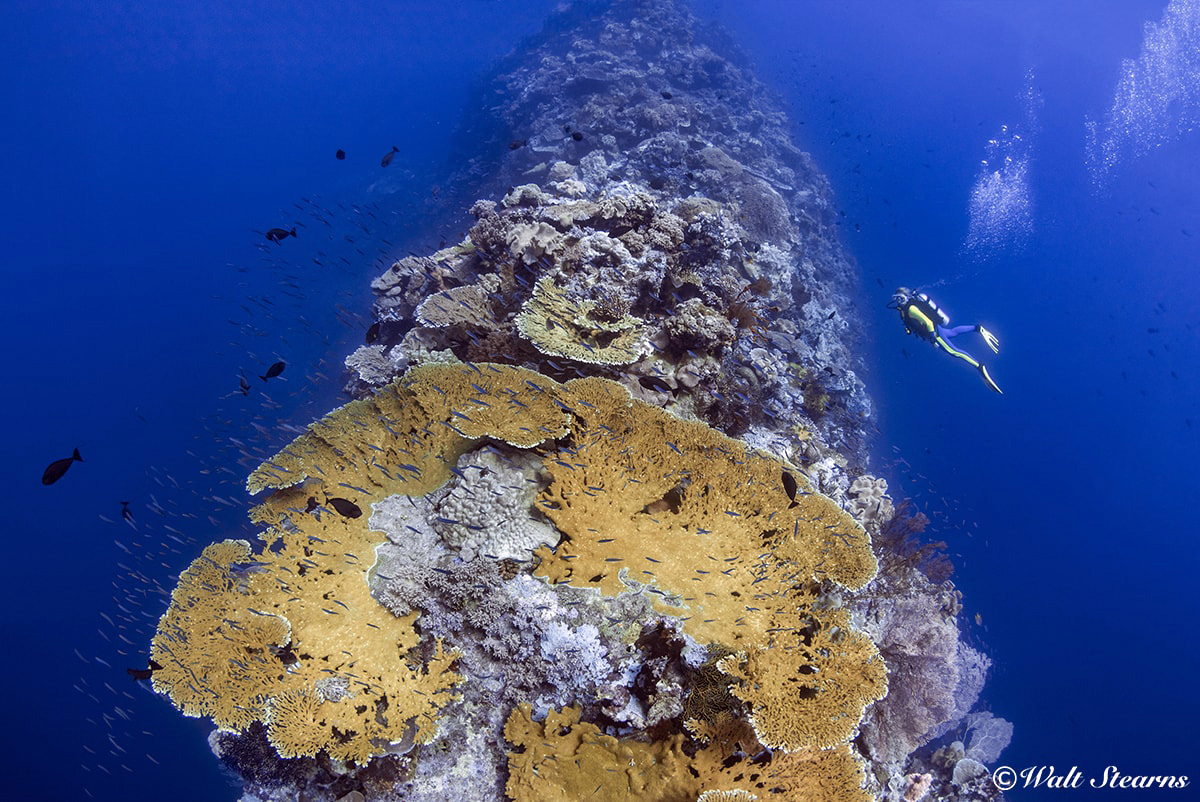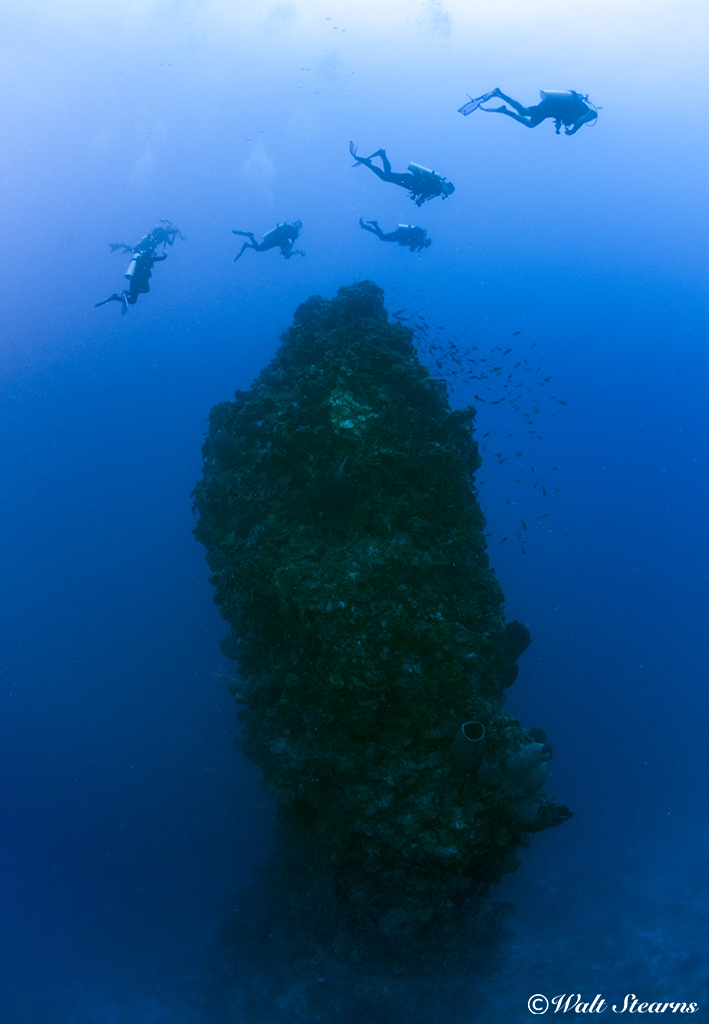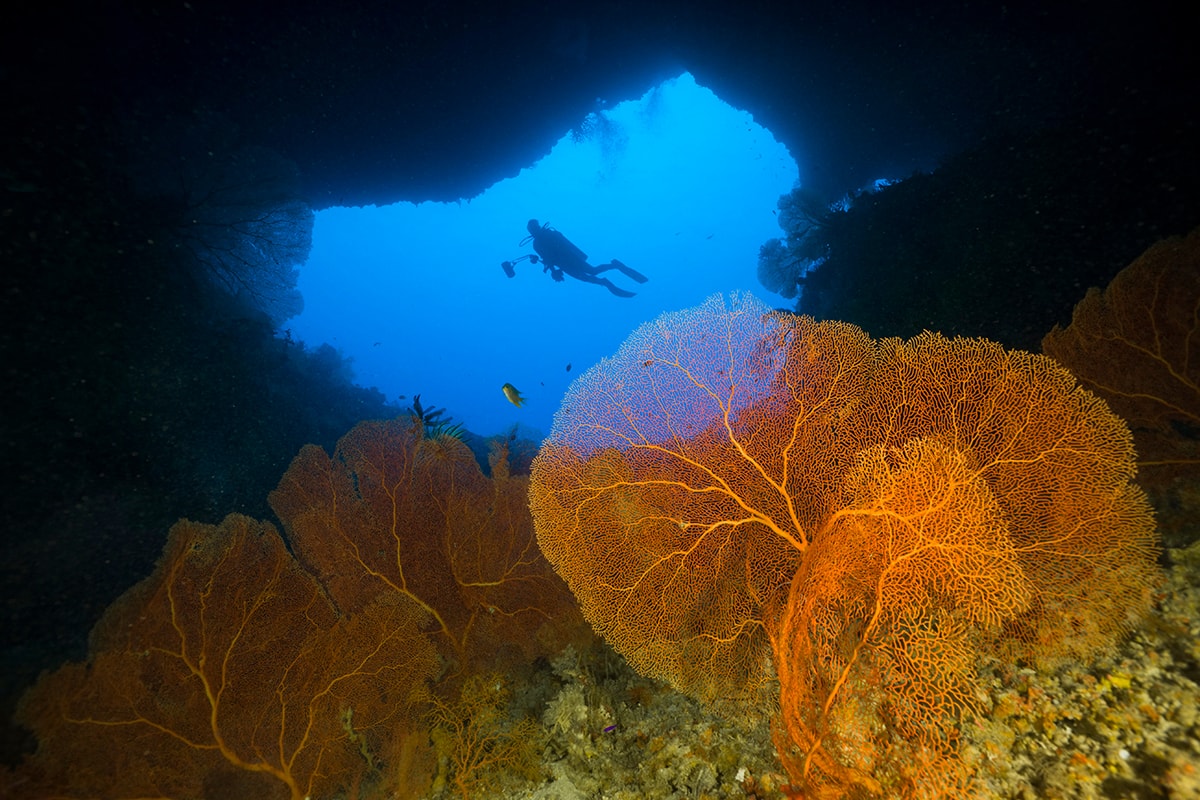
A collection of the underwater world's most awe inspiring and photogenic formations
Some dive sites are famous for big fish. Others are renowned for the small stuff, or the vibrancy of the corals. And then there are those places where the underwater landscape itself takes center stage, with exaggerated vertical features that create awe-inspiring vistas. Here are seven famous formations that should be on every diver's list. And the good news is that you don't need an expedition team to reach these underwater anomalies. All can be visited from resorts and liveaboards represented by us.
1. Bloody Bay Wall

It's the steepest, shallowest wall in the Caribbean—and the most famous. On the north coast of Little Cayman Island, Bloody Bay Wall is a sheer vertical face that begins at a mile-wide coral plateau, dropping from snorkel depths to more than a mile. Adding to the drama are the sponges. There are prolific growths of yellow tubes sponges, cream-colored and orange vases, emerald-green tubes, red ropes and azure-blue baskets. It's one of the most colorful underwater scenes in the Cayman Islands. The Wall isn't actually a dive site; it's a continuation that runs parallel to the shoreline, taking in more than a dozen sites. One favorite is Randy's Gazebo, where divers can enter a vertical cleft that begins at 20 feet, and opens out on the wall at 100. Bloody Bay also provides excellent opportunities for extended multi-level profiles that turn safety stops into critter hunts among the shallow corals. Plus, the nooks and crevices of the Wall are one of the best places in the Cayman Islands to find Nassau grouper.
Do It: Give us a call at 800-330-6611 or send us an email at sales@caradonna.com for the latest information on dive packages to Little Cayman Island.
2. The Blade

It's the most distant site visited by the day boats of Wakatobi Resort, and those who have seen it say the hour-long transit is well justified. A giant stride into clear water reveals a long, narrow seamount that rises to within 15 feet of the surface. There is usually a mild current, and divers drifting above this ridge can actually see down both sides from a central vantage point. Dropping from overhead to either side of the pinnacle reveals near-vertical surfaces covered in soft corals and riddled with crevices and caverns, some of which extend all the way through the center of the pinnacle. The dive doesn't end when the pinnacle drops down to a deeper ridge at a depth of 60 feet because just ahead, another almost identical pinnacle rises towards the surface. In all, there are four of these elongated projections running in parallel, and when seen in profile the entire formation resembles a giant serrated-blade knife set on edge.
Do It: Call us at 800-330-6611 or send us an email at sales@caradonna.com to reserve a beachfront bungalow and dive package at Wakatobi, or to book a trip aboard their luxury liveaboard.
3. Palancar Caves

Cozumel's most famous reef can't be seen in a single dive. In fact, the area known as Palancar is made up of a three-mile-long group of coral formations ranging from depths of 20 feet to more than 100. The most exciting dive in this area is known as Palancar Caves. Here, a coral wall rears up more than from a sand plateau in depth of 40 to 50 feet and runs parallel to the shoreline. On the open water side, the reef abruptly drops off to a depth of 80 to 90 feet before transitioning into a completely vertical wall that disappears into the depths. This south-to-north formation is riddled with deep canyons, tunnels and large caverns. Divers can wind their way back and forth through the reef itself, popping out into the blue water at the outer end of a serpentine swim-through, and then retreating into the next labyrinth. The deep blue waters on the ocean side of the reef can be mesmerizing, but it's also a good idea to keep an eye out for passing eagle rays that glide along the sand flats on the inside of the ridge.
Do It: We represent nearly a dozen of Cozumel's premier dive resorts and can create packages for every budget and interest. Call us at 800-330-6611 or send us an email at sales@caradonna.com
4. Eye of the Needle

In most any dive destinations, the cluster of steep offshore pinnacles known as Third Encounter would be a signature attraction. But in the waters of Saba, these formations could be considered a warm-up for one of the most unusual geological features in the Caribbean. A short swim into open water and away from the main grouping will lead divers to an impossibly thin volcanic spire rising from a depth of 180 feet. At most, this volcanic column is a mere 25 feet in diameter, and near its peak, it tapers to a width of just a few feet. Corals cover the surfaces and schooling fish circle, but it is the seemingly-impossible profile that remains the star attraction. To learn why this site is known as the Eye of the Needle, a diver would have to make a deep dive to the base, where a cavern cuts through the center of the spire, like a giant, well... eye of a needle.
Do It: The best way to visit the Eye is aboard a liveaboard dive boat, which we can easily arrange. Call us at 800-330-6611 or send us an email at sales@caradonna.com
5. The Great White Wall

Fiji's Rainbow Reef is famous for its kaleidoscopic soft corals, which come in every shade of from red, yellow, orange, to evergreen, purple and indigo. But the most stunning underwater venue of all is clad in white. The dense profusion of sea fans that cover the Great White Wall is actually a pale ice blue, but the visual effect is reminiscent of a snow-covered cliff. This wall drops vertically from 30 feet to beyond 140. Floating weightless on the face of this wall is a highlight of any trip to Fiji, but there's more to the wall that just its color. The upper portion of the formation is covered in some of the region's best hard coral growths. Using a multi-level dive plan, it’s possible to explore the wall in its entirety, and still have plenty of bottom time to hunt for the profusion of marine life that thrives near the top.
Do It: The Great White Wall and Rainbow Reef are visited by several dive resorts represented by us.Call us at 800-330-6611 or send us an email at sales@caradonna.com
6. Blue Holes at Blue Corner

Palau's most famous dive site is a coral ridge that extends outward from the reef line to form a massive two-sided rampart, with walls that fall into unseen depths. When currents wash over this projection, everything shows up, including huge schools of fish and plenty of sharks—as many as a dozen different species. To witness this spectacle, divers hang in the current on a tether line know as a reef hook, suspended in the flowing water like a human aqua kite. For even more thrills, divers can begin their Blue Corner adventure close to the surface, where they drop into one of several vertical cavities in the reef top that lead straight down into a large cavern. Depths of 75 feet and 120 feet, bus-sized openings create picture windows into open water. After admiring the view, divers then swim out and onward to the corner itself.
Do It: We offer both land-based and liveaboard packages that include the Blue Hole. Call us at 800-330-6611 or send us an email at sales@caradonna.com
7. Roca Partida

This volcanic spire really is in the middle of nowhere. Some 250 miles southwest of Cabo San Lucas, a twin-peaked pinnacle punctuates the vast blue plane of the Pacific Ocean. It is the visible summit of an underwater mountain that rises from depths beyond 4,000 feet. The visually amazing quality of the rock isn't revealed until you slip below the surface, and discover an oval column that drops straight down more than 200 feet before transitioning into a steep slope. Divers can easily circumnavigate the tower on a single dive, but the spectacular topography is actually just icing on the cake. This stand-alone pinnacle attracts lots of big things that swim in from the blue. There are manta rays, silky sharks, Galapagos sharks, Silvertips, scalloped hammerheads, and tigers. Large schools of yellowfin tuna, big-eyed jacks and wahoo gather and circle, billfish glide in from open and there's always a chance of bottlenose dolphin, false killer whales or a seasonal visit from humpback whales.
Do It: We can arrange passage on a luxury liveaboard that visits Roca Partida and other big animal sites in the Socorro islands. Call us at 800-330-6611 or send us an email at sales@caradonna.com